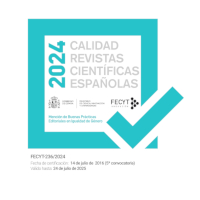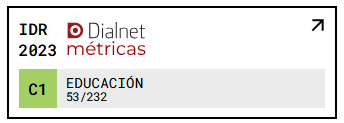Alternativas al mito de la idea principal
DOI:
https://doi.org/10.18172/con.496Abstract
In this work, we analyze how to approach new strategies for teaching students "how to learn" from text, which represent an important demand for educational guidance in Secondary Schools. Both the tutorial and the educational intervention have been traditionally guided toward the instruction of semantic strategies and "study techniques", toward the extraction of main ideas from the text. Other alternative has provided more effective tools to analyse the structure of the text, in order to develop reasoning and comprehension capacities involved. We discuss the main problem and advantages about these perspectives and defend a proposal that, in previous studies, has shown clear improvements in the strategies facing the study of academic texts in the Social Science area.Downloads
References
ADAMS, A. y otros (1985). Estrategias de instrucción para el estudio de textos disciplinares en los grados intermedios. Infancia y aprendizaje, 31-32, 109-128.
ALONSO TAPIA, J. y CARRIEDO, N. (1996). Problemas de comprensión lectora: evaluación e intervención. En Monereo, C. y Solé, I. (coords.). El asesoramiento psicopedagógico: una perspectiva profesional y constructivista. Madrid: Alianza, 97-111.
ALONSO TAPIA, J.; CARRIEDO, N. y otros (1992). Leer, comprender y pensar: desarrollo de estrategias y técnicas de evaluación. Madrid: Servicio de publicaciones del M.E.C.-CIDE.
ÁLVAREZ, M. y otros (1988). Métodos de estudio. Barcelona: Martínez Roca.
AMBRUSTER, B. B. y OSTERTAG, J. (1987). Does the structure summarization instruction facilitate learning from expository text? Reading Research Quarterly, XXIV, 331-346.
BAUMAN, J. F. (1983). A generic comprehension instructional strategy. Reading World, 22, 284-294.
BAUMAN, J. F. (1990). La comprensión lectora: cómo trabajar la idea principal en el aula. Madrid: Visor.
BROOKS, L. W. y DANSERAU, D. F. (1983). Effects of structural schema training and text organization on expository prose processing. Journal of Educational Psychology, 75, 811-820.
BROWN, A. L.; DAY, J. D. y JONES, R. S. (1983). The development of plans for summarizing texts. Child development, 54, 968-979.
BRUNET, J. J. (1987). Cómo programar las técnicas de estudio en EGB. Madrid: San Pío X.
CAÑAS, J. L. y HERNÁNDEZ, T. M. (1989). Ayudar a autoestudiar. Madrid: Narcea.
CARREÑO, P. A. (1976). Estudiar, distinto de aburrirse. Entrenamiento para el estudio. Madrid: Rialp.
CARRIEDO N. y ALONSO TAPIA, J. (1991). Enseñanza de ideas principales: algunos problemas para el paso de la teoría a la práctica. Comunicación, lenguaje y educación, 9, 97-108.
CARRIEDO N. y ALONSO TAPIA, J. (1994). ¿Cómo enseñar a comprender un texto? Madrid: I.C.E.-UAM.
CARRIEDO, N. (1996). Consideraciones metodológicas sobre los programas de instrucción en comprensión de las ideas principales y sobre su eficacia. Infancia y aprendizaje, 73, 33-42.
CASIDY. M. y BAUMAN, J. (1989). Cómo incorporar las estrategias de comprensión a la enseñanza con textos-base de la lectura. Comunicación, Lenguaje y Educación, 1, 45-50.
CUENCA, F. (1989). Cómo estudiar con eficacia. Madrid: Escuela española.
CUNNINGHAM, J. W. y MOORE, D. W. (1990). El confuso mundo de al idea principal. En Bauman, J. F. (Comp.). La comprensión lectora: cómo trabajar la idea principal en el aula. Madrid: Visor.
CHI, M. y otros (1994). Eliciting self-explanation improves understanding. Cognitive Science, 18, 439-477.
DANSERAU, D. F. y otros (1979a). Development and evaluation of learning strategy training program. Journal of education psychology, 71, 64-73.
DANSERAU, D. F. y otros (1979b). Effect of learning strategies training on text processing. Boston: Meeting of the american educational research asociation.
GARCÍA-MADRUGA, J. A. y otros (1995). Comprensión y adquisición de conocimientos a partir de textos. Madrid: Siglo XXI.
GÓMEZ, P.C. y otros (1995). Programas de Técnicas de Trabajo Intelectual. Manual del profesor. Madrid: EOS.
HERNÁNDEZ, P. y GARCÍA, L. A. (1991). Psicología y enseñanza del estudio. Madrid: Pirámide.
KINTSCH, E. y KINTSCH, W. (1995). Strategies to promote active learning from text: individual differences in background knowledge. Swiss Journal of Psychology, 54, 141-151.
KINTSCH, W. (1988). The role of Knowledge in discourse comprehension: a construction-integration model. Psychological Review, 2, 163-182.
KINTSCH, W. y VAN DIJK, T. A. (1978). Toward a model of text conprehension and production. Psicological Review, 85, 363-394.
LEÓN, J. A. (1991). Intervención en estrategias de comprensión: un modelo basado en el conocimiento y aplicación de la estructura del texto. Infancia y aprendizaje, 56, 77-92.
LEÓN, J. A. y CARRETERO, M. (1995). Intervention in comprehension and memory strategies: knowledge and use of text structure. Learning and instruction, 5, 203-220.
MARTÍN, E. (1993). Leer para comprender y aprender: Programa de comprensión de textos. Madrid: CEPE.
MEYER, B. J. F. (1984). Organizational aspect of text: effect of reading comprehension and aplication for the clasroom. En J. Flood. Promoting reading Comprehension, I.R.A.
MEYER, B. J. F. (1985). Prose analysis. puposes, procedures, and problems. En K. Britton y J. B. Black (Comps.). Understanding expository text. Hillsdale: LEA.
MONTANERO, M. (2000). La instrucción de estrategias de comprensión en el ámbito sociolingüístico del segundo ciclo de la E.S.O. Una propuesta didáctica para “enseñar a comprender”. (Tesis doctoral inédita). Universidad de Extremadura.
ORRANTIA, J.; ROSALES, J. y SÁNCHEZ, E. (1998). La enseñanza de estrategias para identificar y reducir la información importante de un texto. Consecuencias para la construcción del modelo de la situación. Infancia y aprendizaje, 83, 29-57.
PERFETTI, C. A.; BRITT, M. A. y GEORGI, M. C. (1995). Text-based learning and reasoning. LEA. Hillsdale, N. Yersey.
ROTGER, B. (1995). Las técnicas de estudio en los programas escolares. Madrid: Cincel-Kaplelusk.
SÁENZ, O. (1988). Técnicas de trabajo Intelectual. En Sáenz, O. (dir.) Didáctica General. Madrid: Anaya, 165-214.
SALAS, M. (1994). Técnicas de estudio. Madrid: Ediciones del Prado.
SÁNCHEZ MIGUEL, E. (1989). Procedimientos para instruir en la comprensión de los textos. Madrid: CIDE.
SÁNCHEZ MIGUEL, E. (1990). La comprensión de textos en el aula. Salamanca: I.C.E.
SÁNCHEZ MIGUEL, E. (1998). Comprensión y redacción de textos. Madrid: EDB.
SÁNCHEZ MIGUEL, E. (1993). Los textos expositivos. Madrid: Santillana.
SELMES, I. (1987). La mejora de las habilidades para el estudio. Madrid: Paidós.
SERAFINI, M. T. (1991). Cómo se estudia. Barcelona: Paidós.
STEVENS, R. J. (1988). Effects of strategy training on the identification of the main idea of expository passages. Journal of Education Psychology, 80(1), 21-26.
TIERNO, B. (1995). Las mejores técnicas de estudio. Madrid: Planeta.
VIDAL, V. (1990). Manual para la confección de programa de desarrollo individual. Técnicas de trabajo Intelectual (volumen 3). Madrid: EOS.
VIDAL-ABARCA, E. (1991). Un programa para la enseñanza de la comprensión de ideas principales de textos expositivos. Infancia y aprendizaje, 49, 53-71.
VIDAL-ABARCA, E. y GILBERT, R. (1991). Comprender y aprender. Madrid: CEPE.
WILLIAMS, J. P. (1986). Teaching children to identify the main idea of expository text. Exceptional Children, 53, 163-168.
Downloads
Published
How to Cite
Issue
Section
License
The authors retain copyright of articles and authorize Contextos Educativos. Revista de Educación the first publication. They are free to share and redistribute the article without obtaining permission from the publisher as long as they give appropriate credit to the editor and the journal.
Self-archiving is allowed too. In fact, it is recommendable to deposit a PDF version of the paper in academic and/or institutional repositories.












